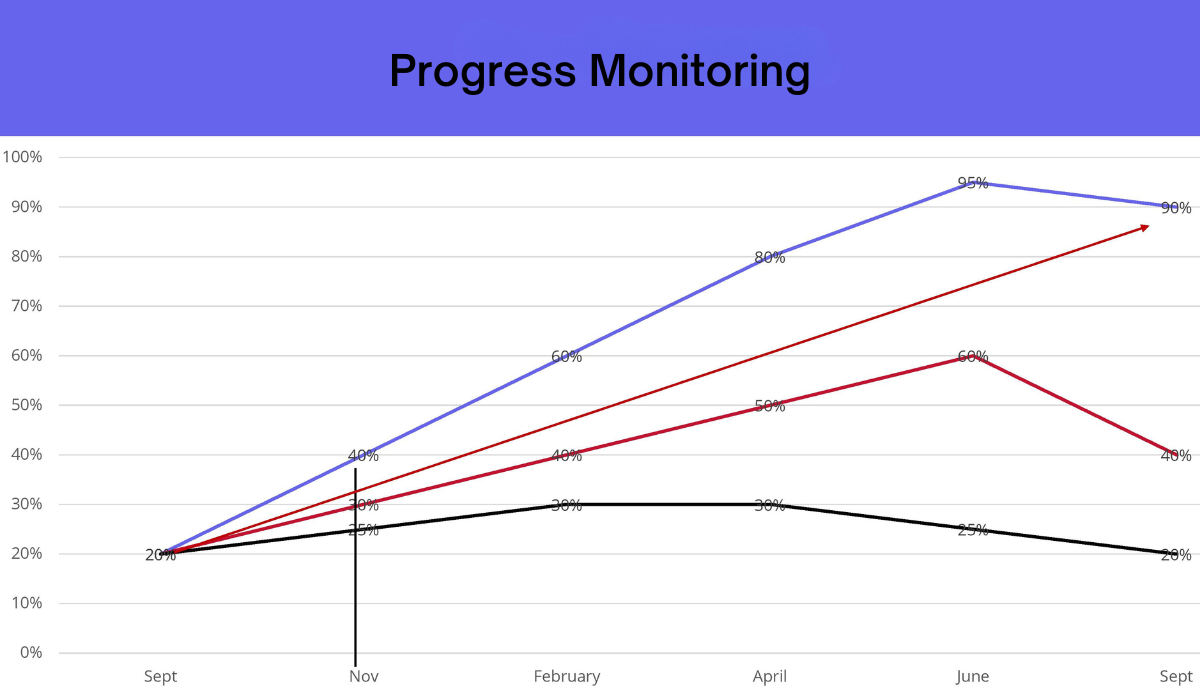Progress monitoring is a scientifically based practice that is used to assess students’ performance and evaluate the effectiveness of instruction. Progress monitoring can be done for an individual students or with an entire class. Progress monitoring is also a part of Response to Intervention.
How do I know if my child is on track to meet their goals?
Parents can answer that question by looking at a variety of data, including information from special education and general education sources, and information from outside the school.
- How Will I Know If My Child is Making Progress? PACER
- Progress Monitoring- What It Means For Your Child
Charting progress on a graph marked with a goal line is a quick visual to see if a child is on track or not on track to meet an IEP goal. More information on making a graph is available in the video link at the bottom of this page .
How does progress monitoring work?
- The student’s current levels of performance are determined and goals are identified for learning that will take place over time.
- The student’s academic performance is measured on a regular basis (weekly or monthly). Progress toward meeting the student’s goals is measured by comparing expected and actual rates of learning.
- Based on these measurements, teaching is adjusted as needed. Thus, the student’s progression of achievement is monitored and instructional techniques are adjusted to meet the individual students learning needs.
What are the benefits of progress monitoring?
Some benefits include:
- assurance that students are receiving more appropriate instruction;
- more informed decisions about teaching methods that work for a specific child;
- documentation of student progress for accountability purposes;
- more efficient communication with families about student’s progress.
Overall, the use of progress monitoring results in more efficient and appropriately targeted instructional techniques and goals.
When can I expect to get progress reports? What will be included?
The IEP must include
- how your child’s progress will be measured; and
- when periodic reports on your child’s progress will be provided to you
Progress reports have to be provided “at least as often as parents of nondisabled children” [§300.320(a)(3)]. This generally means when students receive report cards. That is the minimum, an IEP team can decide that more frequent reporting of progress is needed to make informed decisions about teaching methods that work for a specific child.
The information on how well a child must perform and how progress will be measured is often called evaluation criteria. Find more on our Goals and Objectives webpage.
What questions can a parent ask about progress monitoring?
• What is my child’s current level of skill?
• How different is my child’s performance from the expectation?
• How will my child’s progress be measured?
• What is the goal and when do we expect the goal to be achieved?
• How well does my child need to perform in order to achieve the goal?
• Is my child making sufficient progress toward the goal?
- Questions for Parent Teacher Conferences Understood.org
What if my child is not making enough progress to master the goal?
Periodic reporting of a child’s progress gives parents and other members of the IEP team the opportunity to review the IEP and make adjustments as needed. You can request (in writing) that the IEP team convene a meeting to review the data and work to identify the reason behind the lack of progress.
- Measuring and Reporting Progress
- Learn more: MiMTSS Michigan’s Multi-Tiered System of Supports Technical Assistance Center



